Reflections on my friendship with Michael Glickman
By Karen Alexander
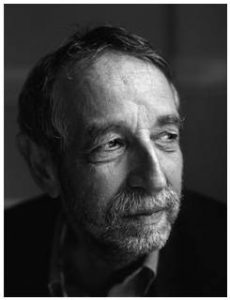
Michael Glickman 1941 – 2020
As I write I am half a century old, but I first met Michael Glickman when I was just 24. I wasn’t even a newcomer to the crop circle circle subject at that age, I had already been involved in the phenomenon for approximately 3 years. We met at a conference in the summer of 1994 and he was with his then partner Patricia Murray, they were both collecting interviews for a book they were working on, I was happy to talk, they were patient and eager listeners. At this point in time Michael was living in California and travelled back to the U.K. each summer to be present for the crop circle season. We just hit it off straight away, it was a meeting of minds, a shared perspective – call it what you want. I think we each recognised in one another a burning curiosity and intense commitment to the crop circle subject, perhaps one born of a shared sense of being called to the phenomenon for some unknown reason.
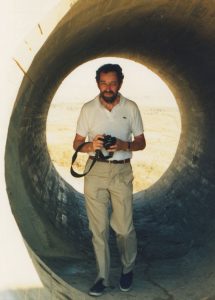
Michael in his younger days worked in the construction design business
Michael brought a considerable intellect and fierce spirit to his work with the crop circles. Trained as an architect at the illustrious and prestigious Arcitectural Association School of Architecture (AA) and with much experience as an inventor in the building-materials design business, he had extensive knowledge of how matter was manipulated and fashioned into ‘things’.
It was abundantly clear he was utterly enchanted by the crop circles, they challenged him as both a designer and a maker of things. His early contact with John Michell, a young John Martineau and many other early pioneers of the crop circle world, only deepened his interest. He once remarked that after visiting the great and iconic East Field crop circle of 1990 – he simply never left. The crop circles represented a whole new world in which he now fully and enthusiastically immersed himself.
His enthusiasm for the subject was infectious, alongside that fierce spirit he brought a child-like playfulness to his work with the geometry of the formations. He often said that the circlemakers offered us the circles as toys on the nursery floor – just to see what we’d make of them. As an architect geometry was his natural way in to approaching the phenomenon. His many insights into harmonious proportions and numbers woven into the designs of the formations is unsurpassed. No one saw the circles quite the way he did; with an expert eye and keen intuition he formed a way of working with the circles which is utilised by researchers today. Many won’t even know who pioneered this approach, but it is one of his biggest legacies to the subject that we still look for hidden geometries in the crop circles, as well as the obvious ones.
He was simply a fantastic lecturer. His talks took on a legendary status in the crop circle community. Always erudite, always insightful, and more often than not, hilariously funny. His fantastic vocabulary enabled him to describe his findings in incredible detail, and his experience as a teacher made him an engaging and entertaining speaker to boot. They also often involved magic tricks which he could pull off with considerable aplomb.
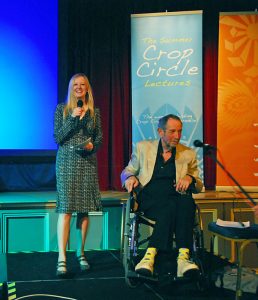
At the Summer Crop Circle Lectures
I recall in particular two talks he gave. One involved a box, a pair of goggles and a pair of heavy duty gloves. He told the audience he had captured a ball of light and was going to open the box and show it to them. Carefully, slowly (with the lights in the auditorium dimmed) and with great suspense he put on the gloves and the goggles and prepared to open the box. The audience roared with laughter, when someone in the front row retrieved his sunglasses from his jacket pocket and promptly put them on in anticipation – as did Michael!
The second one involved a tuxedo, a broadsheet newspaper and a white bed sheet. Michael was the first speaker on after lunch and he sat on the stage in his tux reading his broadsheet under the sheet all the time while the audience re-entered the auditorium and took their seats. His talk began with the sheet being whipped off “There you are!” he exclaimed to the audience as if he’d been sat there collecting dust since last year!
I found in him a fellow seeker, a friend and eventually a peer. We were as one friend succinctly put it ‘Platonic Solids’. He was a mentor for many years when it came to my understanding of geometry. He was a generous teacher, sharing not only his work, but sources of information, books and other materials that nurtured my own drawing practices. Eventually we shared our drawings in progress, often collaborating on our understanding of whatever circle we happened to be working on.
In return, I would share my developing ideas with him. He could be a wonderful sounding board. I’ve lost count of the many articles and essays I read to him over the years that I’d written, he always had a clarifying turn of phrase to offer, some word of encouragement.
Eventually, Michael returned to live in the U.K. full time. His house at Horton in Wiltshire became the unofficial centre of crop circle studies for many years. He had a metallic rendering of the Roundway Splash formation of 1999 erected on the side of the house – you could clearly see it as you traveled the road from Alton Barnes to Devizes. The thought of driving down that road and not seeing it leaves a lump in my throat that is hard to bear.
In those heady summer months, No. 6 Townsend Cottages became a Mecca for crop circle visitors. As well as researchers passing through with news or photos of a new circle, Michael hosted his Crop Circle Teatime groups there, usually on the large deck in his garden (which he designed himself). Here he would enchant many others with the same fierce spirit and intellect, and childlike wonder that were his trademarks. I never tired of seeing him work his magic on others.
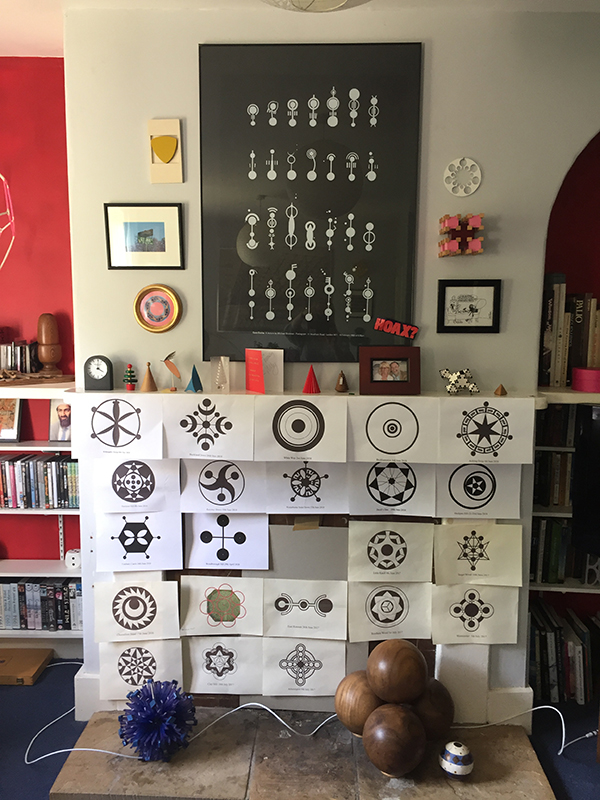
Michael’s annual drawing display around his fireplace
His home was a magical place full of objects that caught the eye. Models he’d made of the circles, hung like mobiles from his ceiling. His walls were full of small works of art, most by people he knew, or had known. His beautiful crop circle posters were there, as was a piece of the Berlin Wall and a satirical cartoon of the Royal family standing on the balcony of Buckingham Palace – completely naked apart from their hats! Each summer he would carefully create his annual crop circle wall (or in his later years he would adorn his fireplace), with his own drawings of that summers formations. He would contemplate them as a group for many hours throughout the winter months. If you stayed with Michael you would very likely stay in what he called his ‘Motel California’, a converted outhouse (conversion designed by himself of course) which had the room number 0.618 on the door! Another addition to the house was his ‘Presidential Library’ complete with brass plaque, and if you ate out with him after a long day in the fields, it would inevitably be Italian fare – his love of all things Italian (including food) was quintessentially Michael.
He of course leaves much work behind for us to treasure. His books are a must read, as are his many columns in the Cereologist, or SC magazine, the blog he diligently toiled over for his website in the last few years, the recordings of his many lectures.
Michael was not without controversy. That fierce spirit of his could equally conjure a stinging rebuke, a biting retort as much as it offered clarity of thought. But it did make him a formidable defender of the phenomenon itself, he had no interest in talk of hoaxing or the manmade, it simply wasn’t part of his consciousness.
He also applied that same fierce spirit when it came to his battle with MS. I watched him over many years bear it with incredible dignity and personal strength, never giving in to the next surrender until he absolutely had too. His tenacity was at times inspirational. Steve, Kayleigh and I were fortunate to travel abroad a handful of times with him to several conferences; how he ever managed the flights and jet lag I’ll never know.
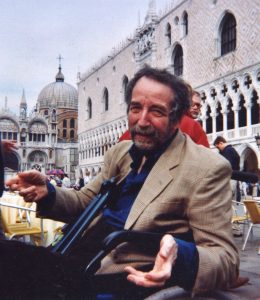
Michael in St. Marco’s Square, Venice on a trip to Italy.
On a personal note, as well as mentor, collaborator and peer, he was a close family friend. He saw my daughter grow from a young child of 5 or 6 into the young woman she is today. Remember those magic tricks I told you about? I remember him performing one for her when she was no more than 6 or 7, it involved making a pencil disappear up his nose – she was so convinced he’d actually done it – shocked she burst into a torrent of tears! She remembers it to this day. I also recall her sat at the front, on the floor for many of his lectures, usually with a colouring book and crayons in hand. He was also there the day Steve and I married, arriving late to the ceremony, because he’d confused Winchester and Chichester (where we actually married) – he’d turned up at Winchester first!
I cannot finish these remembrances with out talking about our estrangement. I had not spoken to Michael for the last 18 months (or so) of his life. After almost 25 years of close contact we suffered a terribly painful and lasting breach in our friendship during the autumn of 2018. A divergence of opinion that proved ultimately to be unbridgeable, both I think knowing that to do so would mean giving up something that lay at the very heart of who we each were. I feel no bitterness, just a deep and profound sadness – that we were unreconciled when he died is almost too painful to be borne. However, I take great solace from one of the last blogs he wrote on his website in which he took some initial thoughts of mine on the Preston Candover crop circle of 2019 and added some observations of his own, it seemed between us still, we had collaborated on yet another formation together. It was to be our last.
Michael leaves a huge empty space at the centre of the crop circle movement. It would be easy to see his sometimes vehement and uncompromising view of the crop circle phenomenon as a flaw in his character, but I think that would be a mistake. Rather it was an expression of that huge, fierce and committed spirit that he brought to everything he did.
Michael died peacefully in his beloved Horton home on May the 1st. He leaves behind three sons of whom he was immensely proud and a clutch of utterly adored grandchildren. I will miss him more than words can say. I am devastated by the loss of my dear friend. Rest now Michael, I will see you again in time.
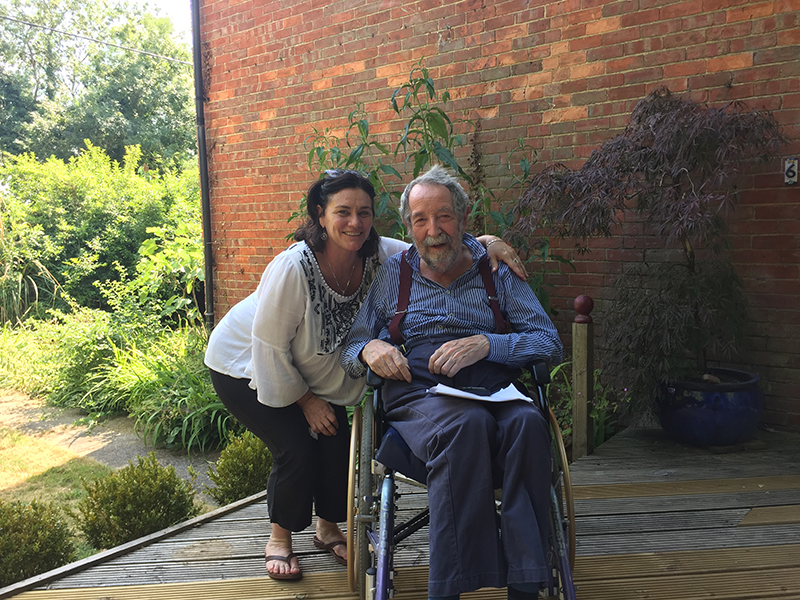
Michael on his deck at home with his dear friend Jineen Cronin in the summer of 2018.
Steve and I would like to extend our deepest condolences to Michael’s family and his many, many friends.
We would like to invite you to leave some of your own remembrances of Michael in the comments section below…


Beautifully written. A man we will both miss so very much. x
Dear Karen,
Your remembrance of Michael is deeply touching for its beauty and truth to the bone. Thanks to you it was a delight to remember some of his outrageous lecture moments. And in what you wrote you captured the feel of your unique rapport with him. It was tangible to be in its presence.
You have honored him here on many levels.I cannot thank you enough for this. So many of my own thoughts and appreciations of Michael have been aired and shared now – by your tender heart. Truly he will never be forgotten. thank you Karen.
Dear Karen,
Thank you so much for the beauty and depth of your tribute to Michael. It is written with such elegance and poignant authenticity, I am in tears as I read it.
We are all as drops of rain, each drop traveling its unique journey and ultimately returning to the ocean. And in that great reunion, all is reconciled.
Dear Karen,
This is a moving and generous tribute. I completely recognise Michael in everything you have said. You have summed him up with remarkable affection and insight.
Thanks. X
Dear Karen,
News of Michael’s passing brought tears to my eyes and your deeply moving and very honest tribute only added to them.
I was fortunate enough to attend a couple of Michael’s presentations when his wit and enthusiasm radiated like quick-silver. He was ever the showman. One day my wife and I were looking for a new crop circle that we knew to be in the vicinity and called on him at his home to ask directions. It was about 10 am and Michael was making his breakfast. Nevertheless, we were invited in for coffee and I was privileged to carry his breakfast to the table for him!
Like so many people with a passion, mixed with the wisdom and enthusiasm, I think there is often a degree of impatience, and I honestly believe that, from where he is now, he is as saddened about the rift that characterised the last years of your friendship as you are. It’s a situation with which I’m familiar and I can understand your sadness. But, as you say, ‘I will see you again in time’, and that is when I don’t doubt you will both laugh about it together. Thank you for all your meticulous work.
Might this be a time to commemorate Michael by setting up a fund to support your work? If you do, I will certainly contribute to it.
Warmest good wishes,
Richard Howard.
Thank you for your heartfelt tribute.
Mr. Glickman called me long distance from the UK sometime during the 1990s. I think it was in response to a fan letter I sent him. His fabulously witty blog posts will be sorely missed!
Thank you Karen for such a wonderful tribute to Michael. Michael was such an important person in my life. The time we spent with him at Horton was very meaningful to me. His stories were priceless and his ribbing of these Americans was also funny and right on. Whenever we get to Wiltshire it with great honor to see crop circles and to listen to Michael talk about them. Karen your tribute is right on and thank you for taking the time to tell us about your relationship.
Dear Karen,
I’m sorry to read that Michael Glickman has made his transition. I was so glad to meet him -and you and Steve -at the Crop Circle lectures of 2009. I’ve read with great interest your fine tribute to Michael. Thank you for sharing it with us.
I came to the crop circle summer lectures in 2018 I think and he gave a talk there. I felt sad not to have caught up with this movement sooner and now I think I obviously missed his best days. But you clearly admired and respected him deeply and what a lovely tribute despite your rift. It takes courage to admit to the truth and to know that you loved him despite your final difference of opinion is what mattered really. And when we all reach the end it is our friends and loved ones’ spirit we remember not the details of our disagreements. In the ‘place’ he is now only love remains
Thank you for your profoundly moving tribute to your great friend. May your many memories comfort you in your loss.
Thank you for posting this remembrance, Karen. I have one of his books up on my shelf, right next to yours and Steve’s. I feel that one of the things the circle makers are trying to teach those of us who are open to it, is to learn to think multidimensionally. This realm of perceived time and space is but a bubble within a wider reality. Something tells me in that wider reality, no rifts between any one and any thing truly exist, ever.
I first met Michael along with both you Karen and Steve, at the Crop Circle conference situated on Lake Champlain at an interfaith church near Burlington, VT in 2010. I had travelled there from my home in Nova Scotia, Canada in a tiny camper van. I didn’t know any of you, yet during those after hour get-togethers, we seemed to acknowledge each other. I was completely enthralled by the depth of knowledge Michael had of his topic and his passionate lecture despite being bound to a wheelchair. I have the CD. hahaha I also have a few of his books, several posters and yearbooks, from the two of you, along with a keepsake calendar to study this ongoing phenomenon. How sad it is that long time friends develop these parting of the ways, when perhaps, both opinions may quite well be fully valid. The Tao of existence demonstrates polarities by using ‘and’ rather than ‘or’.
Thank you Karen.! A lovely tribute to a remarkable, dedicated, focussed and often riotously funny man. I first met Michael in 1996 at a Big Green Gathering. I was introduced to him by my dear friend John Martineau. Michael laid into me without further ado, something that has been repeated since that meeting. How he loved to rattle cages, and equally how he became delighted if someone challenged him back, a guarantee that you’d have a friend for life. A sparring partner. Someone from the old school, a highly erudite and clever man with whom to debate almost any subject. And that is what Michael has been to Trish and myself, largely via the fortnightly telephone call and two or three annual visits to Townsend Cottages in Horton.
His personal involvement with Ronnie Scott’s Jazz club in the 60s further cemented the bond, as did his raconteur stories, ripping yarns and funny asides. And now he has gone from us, in the same month that the doyen of stone circles, Aubrey Burl, passed on, also one of the founding fathers of RILKO, Keith Critchlow. These guys were the bedrock of the modern interest in Geometry and the study of unknown entities, be they Neolithic or otherwise who worked with geometry as a working language of the soul. We shall miss all of these great people, but Michael also made us laugh.
Dear Karen,
Michael was an important part of my life as well. I will never forget the time I spent with him. I’ve learned a lot from him and I am lucky I had so many lovely, and always funny, conversations with him. The little film we did all together is still so interesting to me and soon I will publish on Youtube “The Woodborough Conversation” with him and Stanley Messenger. I have some never edited interviews with Michael and sooner or later I’ll put it together.
Yes, you are right, Michael was not an easy person, but it was just a part of his brilliant mind not inclined to compromise.
I hope we will all meet somewhere in England one day to remember our dear friend and have some great time together again.
Best wishes to you and Steve from Duperissimo, as Michael used to call me.
Unfortunately, I was not aware of his passing in January. I also have fond memories of Michael. Back in 2010 I had the pleasure of meeting him and spending the day at his home. I was there for a crop circle tour with Barbara Lamb, and he graciously invited our entire group of 8 people to his home for tea and a talk. He was delightful in his witty sharing about crop circles and other mysteries of the universe. We spent the afternoon on his back deck listening intently to his talk filled with animated gestures. He wore no shoes but on his feet were socks covered with cartoons. I did a video tape of that day and I will post it on my Facebook as a memorial.
Hi Karen.
I just learnt about Michael’s passing today. I met him on a couple of I believe. He was an authority on the circle phenomena and and he will be missed. Thank you for the tribute.
Best wishes to you Steve x